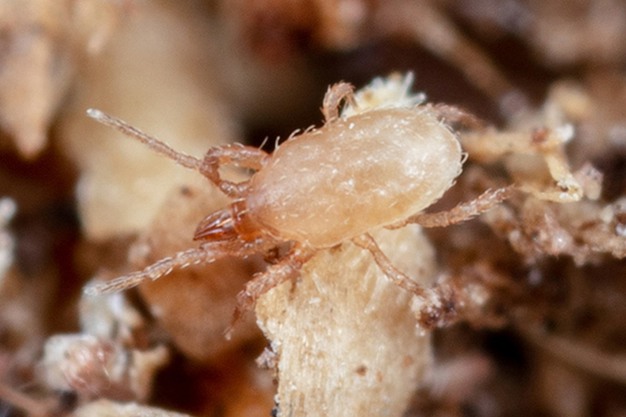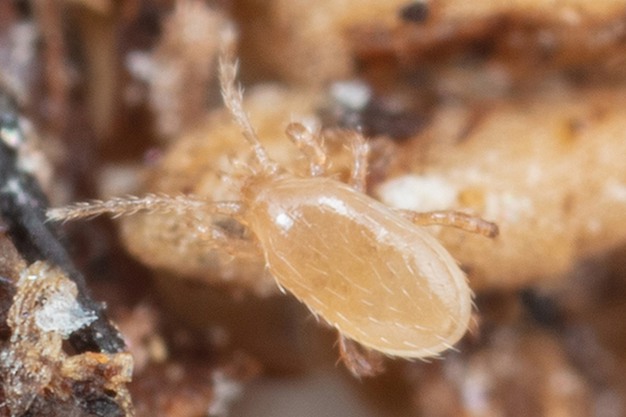In biological pest control, two mite species, Stratiolaelaps scimitus and Gaeolaelaps gillespiei, have emerged as allies for sustainable farming. These mites belong to the Laelapidae family within the Mesostigmata order, a diverse group that thrives in soil, leaf litter, compost, and other organic matter-rich environments, where they play an essential role in maintaining healthy agroecosystems. "The name Laelapidae comes from the Greek word laílaps, meaning 'storm' or 'hurricane,' capturing their relentless power," says Dr Omid Joharchi, of Anatis Bioprotection.
Stratiolaelaps scimitus: the guardian mite
Stratiolaelaps scimitus is known as the "guardian mite" for its effectiveness in managing soil-borne pests in greenhouses. Its adaptability across various substrates makes it particularly effective at targeting fungus gnats, thrips pupae, and root aphids. "These mites provide broad-spectrum control, offering growers a sustainable and resilient alternative to chemical treatments," Omid explains. Stratiolaelaps scimitus is especially suited for greenhouse environments, giving growers consistent, long-term protection across growing cycles.

Adult Stratiolaelaps scimitus
Gaeolaelaps gillespiei: the Canadian champion
Complementing Stratiolaelaps scimitus is Gaeolaelaps gillespiei, a Canadian native mite lauded for its efficiency in pest control, particularly against fungus gnats and thrips. "Gaeolaelaps is nearly 50% more effective at suppressing fungus gnats compared to Stratiolaelaps," says Omid. Known as the "Canadian champion," Gaeolaelaps gillespiei is highly effective on coco-fiber mats and rock wool, making it ideal for greenhouse crops. It's surface-oriented, adapting well to substrates in Canadian climates, and helping local growers manage pest populations sustainably.
 Adult Gaeolaelaps gillespiei
Adult Gaeolaelaps gillespiei
Wide-ranging pest control for greenhouse ecosystems
These two mite species form a line of defense against a wide range of pests. Stratiolaelaps and Gaeolaelaps target not only fungus gnats and thrips but also pathogenic nematodes, springtails, Black Vine Root Weevil, Strawberry Root Weevil, symphylans, and overwintering spider mites. "They're indispensable in greenhouse ecosystems, especially during crop rotations when pests hide in cracks and crevices," Omid explains. He adds that there's no better way to "clean out" a greenhouse than by placing these mites in areas where pests could overwinter, such as around posts or plumbing.
Flexible application for diverse growing media
The application of Stratiolaelaps scimitus and Gaeolaelaps gillespiei is adaptable across potting soil, coconut fiber, rock wool, and other growth media. In potted plants, propagation trays, and other indoor growing setups, these mites establish strong colonies, ensuring reliable pest control. However, they cannot survive in flooded or freezing conditions. To ensure their effectiveness, Omid recommends a two-stage introduction with a 2- to 3-week interval between applications. "For preventative use, we recommend an introduction rate of 100 to 200 mites per square meter," he notes, "while for curative treatments, 250 to 500 mites per square meter can be effective."
The growing role of bio-control
With an increasing focus on sustainable agriculture, Stratiolaelaps scimitus and Gaeolaelaps gillespiei offer an environmentally-friendly solution for pest management that supports soil health and reduces chemical dependency. "These mites are proving to be adaptable, resilient, and powerful tools for greenhouse and indoor production systems alike," Omid concludes.
References for scientific information:
Beaulieu, F. (2009) Review of the mite genus Gaeolaelaps Evans and Till (Acari: Laelapidae), and description of a new species from North America, G. gillespiei n. sp.. Zootaxa, 2158 (1), 33–49. https://doi.org/10.11646/zootaxa.2158.1.3
Joharchi, O., Döker, I. & Khaustov, V.A. (2021a) Two new species and a new record of Gaeolaelaps Evans & Till (Acari: Lealapidae) from Altai Mountains, Russia. Zootaxa, 4949 (2), 240–260. https://doi.org/10.11646/zootaxa.4949.2.2
Lindquist, E.E., Krantz, G.W. & Walter, D.E. (2009) Order Mesostigmata. In: Krantz, G.W., Walter, D.E. (Eds.) A Manual of Acarology. Third Edition. Texas Tech University Press, Lubbock, pp. 124–232
Walter, D.E. & Campbell, N.J.H. (2003) Exotic vs endemic biocontrol agents: would the real Stratiolaelaps miles (Berlese) (Acari: Mesostigmata: Laelapidae), please stand up? Biological Control, 26, 253–269. https://doi.org/10.1016/S1049-9644(02)00171-8
Register for the Anatis Knowledge Academy: simpli.events
Follow their weekly publications on their LinkedIn profile: linkedin.com
For more information:![]()
Anatis Bioprotection
anatisbioprotection.com
